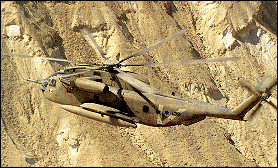 Egyptian P-12
Egyptian P-12The War of Attrition raged along the Suez canal from the end of the Six Days War in 1967 until a ceasefire agreement in 1970. The Egyptian military effort was supported by Soviet shipments of military equipment which was of great interest to Israeli intelligence. The IDF had used equipment captured during the Six Days War to better deal with enemy threats, using captured radars to learn the weaknesses of the Egyptian air defence and to develop electronic warfare methods. The aqcuired knowledge was of great value and gave the IAF the edge over enemy air defences, yet by 1969 it was becoming apparent that electronic warfare and other methods used to trick Egyptian radars were becoming less effective and that Israeli operations were being hampered by earlier detection of incoming aircraft.
Newer radars had obviously arrived in Egypt and an effort was under way to learn how to deal with this new threat. The break came after an air defence array destroyed during a september 1969 armour raid came back on line in a different configuration, much harder to penetrate. (the armour raid had actually used captured Soviet tanks and armoured personnel carriers to operate an entire day inside Egyptian territory.) Reconaissance missions were quickly launched to photograph the new air defence array and soon enough a new P-12 Sovier radar was located on the beach of Ras-Arab. The immediate response was to destroy the new radar station with an aerial strike, but the attacking aircraft were stopped shortly before takeoff when an idea to capture the entire installation came up.
 Egyptian P-12
Egyptian P-12Nicknamed "Rooster-53", the operation was planned in just a few days, beginning on December 24th. After getting approvement from the IDF chain of command, the details and mechanics of the operation were soon ironed out and the forces involved began their training on radars captured during the Six Days War. The helicopters selected to carry the radar station to Israeli territory were the new Sikorsky CH-53 Yasur which had only arrived in Israel shortly before. These were the only helicopters deemed capable of carrying the entire radar station, estimated at 7 tons.
The operation was finally launched at 21:00 on the eve of December 26th, 1969. A-4 Skyhawks and F-4 Phantoms began attacking Egyptian forces along the western bank of the Suez canal and Red Sea. Hidden by the noise of the attacking jets, three Aerospatiale Super Frelons, carrying Israeli paratroops, made their way west towards their target. Making their approach carefully in order not to be spotted beforehand, the troops surprised the light security contingent at the radar installation and quickly took control of the site. By 02:00, december 27th, when the paratroops had taken apart the radar station and prepared the various parts for the CH-53s, the two Yasurs were called in from across the Red Sea. One CH-53 carried the communications caravan and the radar antenna, while the other took the heavier, 4 ton radar itself. The two helicopters started making their way back across the Red Sea to Israeli controlled territory.

The 4 ton radar caravan was actually heavier than the CH-53 was designed to carry and soon endangered the safe completion of the operation. The cables connecting the radar to the helicopter were streching the ribs of the aircraft which in turn caused a hydrolic pipeline to rupture. Faced with either releasing the radar or loosing control of the aircraft and crashing, the captain of the helicopter managed to cross the water line into Israel. With the last of its Hydrolic pressure, the Helicopter set down the radar and landed besides it. The second CH-53 which had already arrived with its lighter load, was sent back to retrieve the radar from the crash landing site. Once again the heavy load almost caused the helicopter to crash but the radar was finally delivered to the designated point, into the hands of awaiting intelligence specialists.
Although an attempt was made to conceal the mission and its success, the operation was made public a week after it took place following its publication in foreign press. The radar itself was studied thoroughly and provided the IAF with new countermeasures against the Egyptian air defences, removing a threat to Israeli air superiority over the Suez Canal. It was later handed over to the USA, the same as other equipment captured before.
 back to the IDF/AF page
back to the IDF/AF page